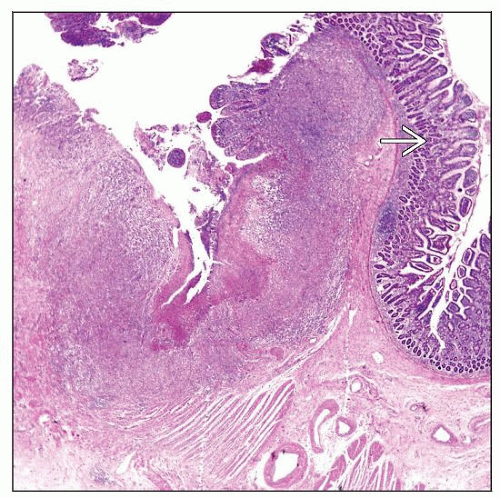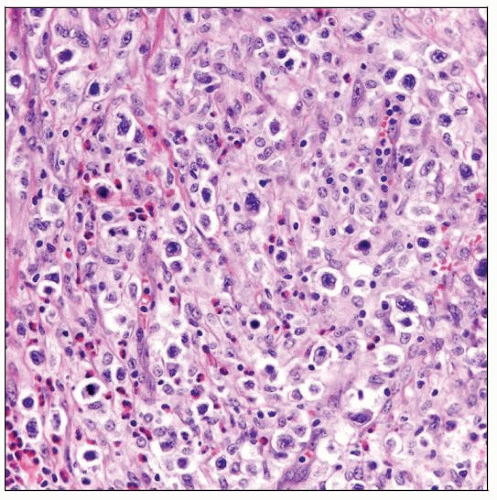Enteropathy-associated T-cell Lymphoma
Sa A. Wang, MD
Key Facts
Terminology
T-cell lymphoma of intestine
Arises from intraepithelial T cells
Etiology/Pathogenesis
Classical cases of EATL arise in patients with evidence of celiac disease
Serologic tests (+); evidence of celiac disease (+)
Associated clinical findings: Gluten intolerance, dermatitis herpetiformis, and hyposplenism
Refractory celiac disease is precursor lesion
In monomorphic variant of EATL, association with celiac disease is not proven
Clinical Issues
Most commonly involves jejunum or ileum
EATL is often initially diagnosed by intestinal resection at time of acute abdomen
Prognosis is very poor due to late diagnosis
Ancillary Tests
Array CGH
Chromosomal gain of 9q31.33-qter or deletions within 16q12.1 (23% of cases)
Top Differential Diagnoses
Peripheral T-cell lymphoma, not otherwise specified
ALK(-) anaplastic large cell lymphoma
Extranodal NK-/T-cell lymphoma, nasal type
Diagnostic Checklist
Available data suggest that EATL can be divided into 2 types: 1 (classical) and 2 (monomorphous)
TERMINOLOGY
Abbreviations
Enteropathy-associated T-cell lymphoma (EATL)
Synonyms
Intestinal T-cell lymphoma
Definitions
T-cell lymphoma of intestine arising from intraepithelial T cells
ETIOLOGY/PATHOGENESIS
Classical Variant EATL (EATL Type 1)
Type 1 comprises 80-90% of cases of EATL
These tumors are associated with celiac disease
Serological tests (+); association with HLA DQ2 or HLA DQ8
Pathologic evidence of celiac disease in uninvolved intestinal mucosa
Associated clinical findings: Gluten intolerance, dermatitis herpetiformis, and hyposplenism
Refractory celiac disease (RCD) is precursor lesion
Definition
Persistent enteropathy-associated histologic changes on biopsy despite strict gluten-free diet for > 12 months or
Severe persistent symptoms necessitating clinical intervention independent of duration of gluten-free diet
In some cases of RCD, intraepithelial lymphocytes show
Immunophenotypic aberrancy
Monoclonal T-cell receptor gene rearrangement
Gain of chromosome 1q
These cases may be considered as EATL in situ
Monomorphic Variant (EATL Type 2)
Association with celiac disease or other risk factors is not proven
10-20% of cases
CLINICAL ISSUES
Epidemiology
Incidence
Annual rate of 0.5-1 per 1,000,000 people in Western countries
Greatest frequency in areas with high prevalence of celiac disease, particularly Northern Europe
Accounts for ˜ 35% of all small intestinal lymphomas
< 5% of all gastrointestinal tract lymphomas
Age
Median: 60 years
Gender
Affects males and females equally
Site
EATL most commonly arises in jejunum or ileum
Often involves mesenteric lymph nodes
Presentation in duodenum, stomach, colon may occur rarely
Lymphomas arising in these sites show genetic alterations similar to classic EATL in jejunum or ileum
RCD can involve duodenum, stomach, or colon
Patients usually do not have peripheral lymphadenopathy
EATL can disseminate to liver, bone marrow, spleen, skin, and other organs
Presentation
Clinical history of celiac disease
Small proportion of patients have childhood-onset celiac disease
Most patients have adult-onset celiac disease
Typical symptoms of celiac disease
Diarrhea with bulky, foul-smelling, floating stools
Malabsorption: Anemia, weight loss, vitamin deficiency
Dermatitis herpetiformis
In some patients, celiac disease and EATL are diagnosed at same time
Most patients with monomorphic variant of EATL do not have clinical history of celiac disease
Clinical findings at time EATL is initially diagnosed
Most patients have weight loss, abdominal pain, and diarrhea
Nonspecific; overlaps with celiac disease
Some patients can have B symptoms
Substantial subset of patients present with small bowel obstruction or perforation
In many of these patients, diagnosis of lymphoma is made by laparotomy
In patients with known celiac disease, lymphoma occurs ˜ 5-10 years after celiac disease diagnosis
Often heralded by clinical relapse after a period of good response to gluten withdrawal
In some patients, lymphoma develops in course of progressive deterioration of RCD
Presentation of patients with monomorphic EATL is similar, except there is no history of celiac disease
Endoscopic Findings
Lymphoma
Multiple ulcerating raised mucosal masses or
1 or more larger ulcers or
Large exophytic mass
Mucosal changes related to RCD
Scalloping, fissuring, loss of folds, or mosaic pattern
Laboratory Tests
Celiac disease
Serology
IgA anti-tissue transglutaminase and IgA endomysial antibody are most sensitive and specific tests
Anti-gliadin antibody tests have low sensitivity and specificity, no longer used routinely
HLA typing
For DQ2 and DQ8 may be useful in individuals with equivocal findings
Treatment
˜ 50% of patients require laparotomy for complications of hemorrhage, perforation, or obstruction
Combination chemotherapy is often used, such as
Cyclophosphamide, doxorubicin, vincristine, prednisolone (CHOP)
Cisplatin, cytarabine, etoposide, methylprednisolone (ESHAP)
Carmustine, etoposide, cytarabine, melphalan (BEAM)
Stem cell transplant
Stay updated, free articles. Join our Telegram channel

Full access? Get Clinical Tree





